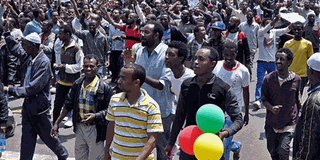Five killed in Ethiopia after weeks of protests over land grabbing

Thousands of Ethiopian opposition activists demonstrate in Addis Ababa on June 2, 2013. The government on Monday said that five people have died following weeks of protests sparked by land grab fears in the Oromia region. PHOTO | STRINGER |
What you need to know:
- Protests have taken place in towns including Haramaya, Jarso, Walliso and Robe, sparked by fears of land grabbing as the capital Addis Ababa expands onto areas traditionally occupied by the Oromo people, the country’s largest ethnic group.
- Pictures have been shared on social media claiming to show bloodied protesters and armed police firing tear gas canisters at student demonstrators.
- Pressure group Human Rights Watch (HRW) said the protests appear similar to those in 2014 when police were accused of killing many.
- The government said eight people died in the 2014 unrest.
ADDIS ABABA, Tuesday
Ethiopia says five people have died in weeks of protests sparked by land grab fears in Oromia region, dismissing opposition reports of dozens dead and many arrested.
“So far we know that five people died,” government spokesman Getachew Reda said, adding that peaceful demonstrations that began last month escalated into violence.
“Now they are terrorising civilians and inciting ethnic groups against others - they even killed administration officials and unarmed policemen,” Getachew said.
He added that some protesters had guns.
LAND GRABBING
Protests have taken place in towns including Haramaya, Jarso, Walliso and Robe, sparked by fears of land grabbing as the capital Addis Ababa expands onto areas traditionally occupied by the Oromo people, the country’s largest ethnic group.
Pictures have been shared on social media claiming to show bloodied protesters and armed police firing tear gas canisters at student demonstrators.
Pressure group Human Rights Watch (HRW) said the protests appear similar to those in 2014 when police were accused of killing many.
“The current protests echo the bloody events of April and May 2014, when federal forces fired into groups of largely peaceful Oromo protesters, killing dozens,” HRW said.
The government said eight people died in the 2014 unrest.
“Both then and today, the demonstrators are ostensibly protesting the expansion of Addis Ababa’s municipal boundary into the surrounding Oromia region, which protesters fear will displace farmers,” HRW said.
“But these protests are about much more: many Oromos feel marginalised and discriminated against by successive Ethiopian governments and have often felt unable to voice their concerns over government policies.”
With nearly 27 million people, Oromia is the most populous of the country’s federal states and has its own language.





